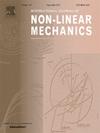非正交错位面齿轮功率分流传动系统非线性动力学模型的建立及分岔特性研究
IF 3.2
3区 工程技术
Q2 MECHANICS
International Journal of Non-Linear Mechanics
Pub Date : 2025-04-29
DOI:10.1016/j.ijnonlinmec.2025.105134
引用次数: 0
摘要
研究齿隙、摩擦和转速对非正交错位面齿轮动力分流传动系统(NOMFGPSFTS)非线性分岔特性的影响,旨在为创新型直升机、船舶和汽车动力传动机构提高功率重量比、延长使用寿命、保证可靠性提供理论依据和技术指导。采用集中质量法建立了11自由度、弯曲、扭转和轴耦合的非线性动力学模型。该模型采用载荷齿面接触分析(LTCA)方法计算非正交错位面齿轮(NOMFG)的啮合刚度,并结合齿轮齿面摩擦、齿隙、支承刚度和传动误差等关键非线性因素,以促进系统动力学的准确表示。采用龙格-库塔算法求解了系统的动态微分方程,并通过时域图、快速傅立叶变换(FFT)谱图、相平面图、庞加莱图和最大李雅普诺夫指数图展示了系统的非线性特性。分岔图用于进一步揭示间隙、转速和摩擦系数对系统非线性行为的影响。研究发现,随着无量纲间隙的增大,系统从周期-1运动过渡到混沌运动,并可能演变为周期-2运动,表现出明显的非线性振动。随着转速的增加,系统由周期-2运动过渡到混沌运动,最终实现周期-1运动。随着摩擦系数的增大,系统混沌区减小。最后通过实验验证了理论模型的正确性,为系统的稳定性研究提供了理论依据。本文章由计算机程序翻译,如有差异,请以英文原文为准。
Establishment of nonlinear dynamic model and study on bifurcation characteristics of non-orthogonal misaligned face gear power split -flow transmission system
Study on the effects of backlash, friction, and rotational speed on the nonlinear bifurcation characteristics of Non-Orthogonal Misaligned Face Gear Power Split-Flow Transmission System (NOMFGPSFTS), aiming to provide theoretical basis and technical guidance for improving power to weight ratio, prolonging service life, and ensuring the reliability of the power transmission mechanism of innovative helicopters, ships and automobiles. An 11 degree of freedom (DOF), bending, torsion and axis coupling nonlinear dynamic model is established by using the lumped mass method. The model uses Load Tooth Contact Analysis(LTCA) method to calculate the meshing stiffness of Non-Orthogonal Misaligned Face Gear (NOMFG), and combines the key nonlinear elements, including gear tooth surface friction, backlash, support stiffness and transmission error, to facilitate an accurate representation of the system dynamics. The system's dynamic differential equations are solved using the Runge-Kutta algorithm, and the system's nonlinear characteristics are demonstrated through time domain diagrams, Fast Fourier Transform (FFT) spectrograms, phase plane diagrams, Poincaré maps and Maximum Lyapunov Exponent diagrams. Bifurcation diagrams are used to further reveal the effects of backlash, rotational speed, and friction coefficient on the system's nonlinear behavior. The study finds that with the increase of dimensionless backlash, the system transits from periodic-1 motion to chaotic motion, and may evolve into periodic-2 motion, showing obvious nonlinear vibrations. With the increase of rotating speed, the system transits from periodic-2 motion to chaotic motion, and finally realizes periodic-1 motion. With the increase of friction coefficient, the chaotic region of the system decreases. Finally, the correctness of the theoretical model is verified by experiments, which provides a theoretical basis for the stability study of the system.
求助全文
通过发布文献求助,成功后即可免费获取论文全文。
去求助
来源期刊
CiteScore
5.50
自引率
9.40%
发文量
192
审稿时长
67 days
期刊介绍:
The International Journal of Non-Linear Mechanics provides a specific medium for dissemination of high-quality research results in the various areas of theoretical, applied, and experimental mechanics of solids, fluids, structures, and systems where the phenomena are inherently non-linear.
The journal brings together original results in non-linear problems in elasticity, plasticity, dynamics, vibrations, wave-propagation, rheology, fluid-structure interaction systems, stability, biomechanics, micro- and nano-structures, materials, metamaterials, and in other diverse areas.
Papers may be analytical, computational or experimental in nature. Treatments of non-linear differential equations wherein solutions and properties of solutions are emphasized but physical aspects are not adequately relevant, will not be considered for possible publication. Both deterministic and stochastic approaches are fostered. Contributions pertaining to both established and emerging fields are encouraged.

 求助内容:
求助内容: 应助结果提醒方式:
应助结果提醒方式:


